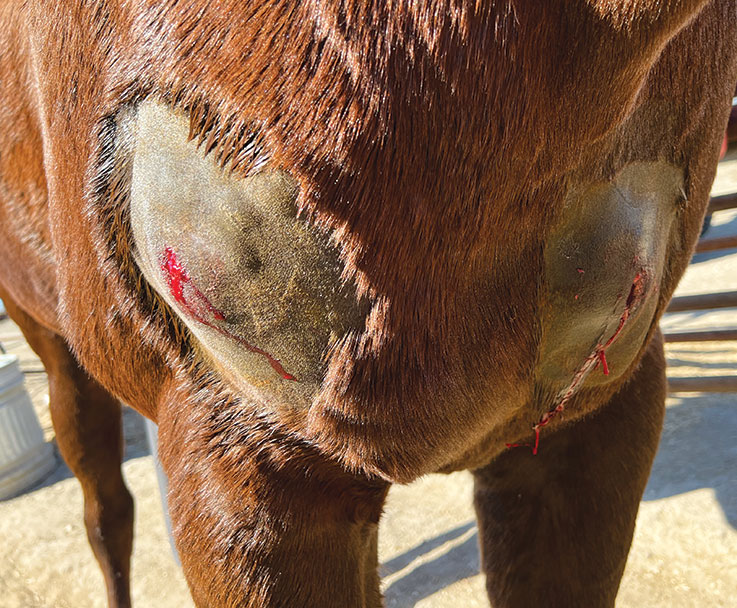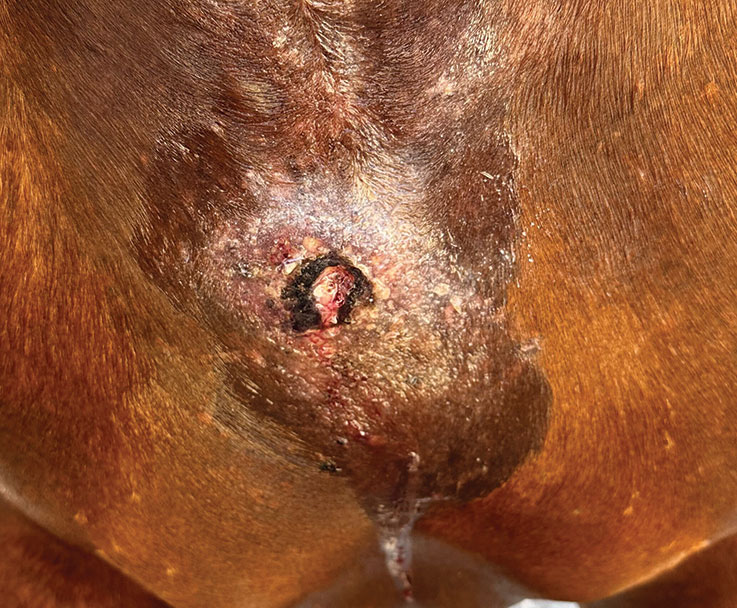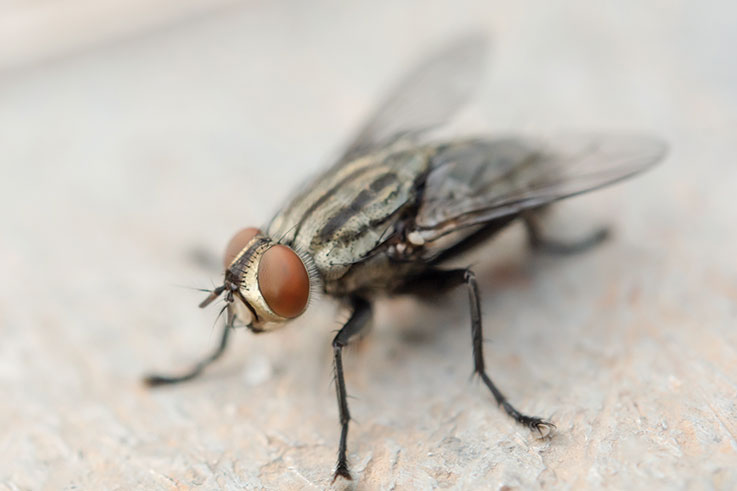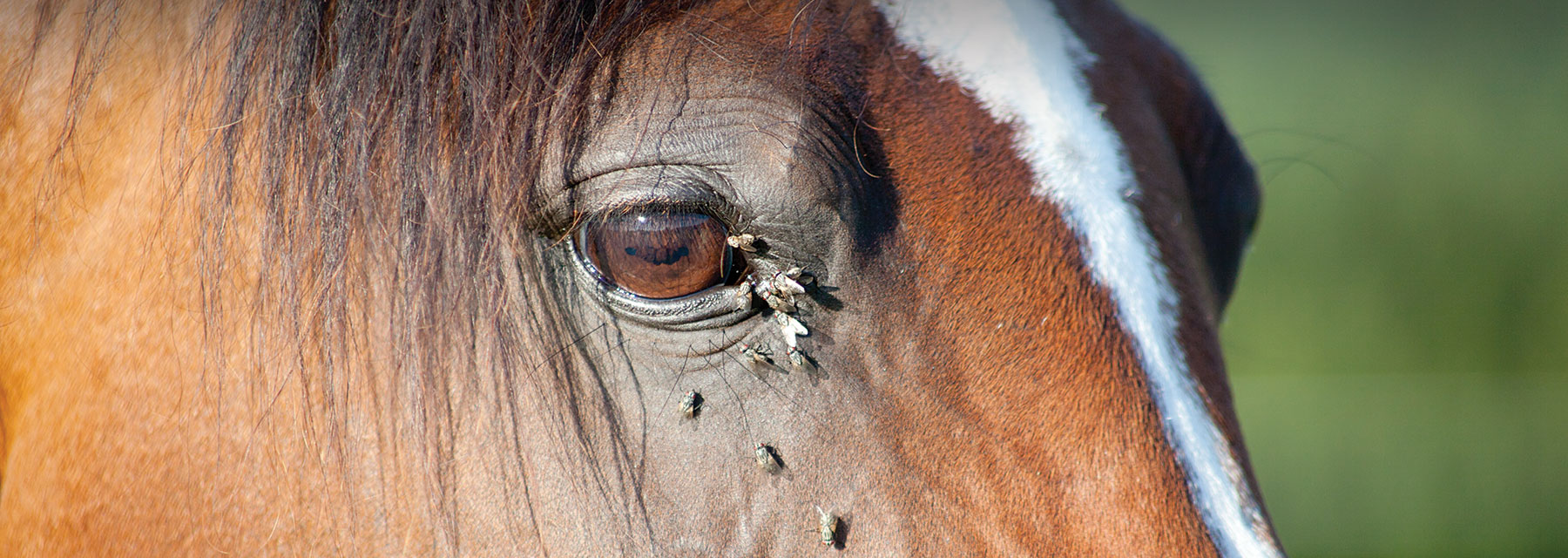Not to be Taken Lightly, This Debilitating Infection Must be Detected and Treated Early On to Result in a Positive Prognosis
As summer comes to a close, swarms of flies seem to appear as a final reminder of why horse owners look forward to the first frost. While annoyance can be the first reason to eagerly anticipate the falloff of flies in winter, keep in mind, during the dry months of summer and fall, these pesky winged insects are more likely to be carrying a host of different diseases, including pigeon fever, sometimes called “dryland distemper” or “false strangles.”
The name pigeon fever comes from the main telltale symptom of the disease: swelling in the pectoral muscles of a horse’s chest that resembles a pigeon’s breast. While most horses overcome the infection quickly with no long-term health effects, about one in 10 cases become much more serious, even life threatening. “While many horse owners have experienced pigeon fever, they seem to forget about the disease because most horses do get over it,” says Sharon Spier, DVM, Ph.D., DACVIM-LAIM, a professor emeritus of medicine and epidemiology at the University of California, Davis, School of Veterinary Medicine, who has published more pigeon fever research than anyone in the country. “If you have one of those horses that gets recurrent external abscesses, internal abscesses or an infection in the legs, then you’ve got a real problem,” she points out. The disease is caused by the bacteria Corynebacterium pseudotuberculosis, and it usually only causes large abscesses on the chest or belly regions. For the unfortunate few that develop more severe symptoms like internal abscesses or ulcerative lymphangitis (limb infection), early veterinary intervention is necessary to fight this debilitating infection. Dr. Spier warns: “Don’t get too nonchalant. Call your veterinarian. The majority of horses will have external abscesses and low mortality rates, but horses with internal abscesses, if missed, they’ll have a much higher mortality rate.”
“I’ve really researched extensively to see if there are new, more virulent strains of the disease, but the strains are all the same. It really seems to be the horse’s own immune system that is the deciding factor on severity of the infection.”
— Sharon Spier, DVM, Ph.D., DACVIM-LAIM, Professor emeritus of medicine and epidemiology at the University of California, Davis, School of Veterinary Medicine
Pigeon Fever Fast Facts
Dr. Spier explains the cause of disease as a triad of infection: the bacteria, its environment and the host itself. “The bacteria, Corynebacterium pseudotuberculosis, is a soil-borne organism that thrives in dry, arid environments,” she says. This is why the disease is prevalent during the dry months of the year and more widely seen in the arid or semiarid southwestern states of California, Arizona, New Mexico and Texas. The bacteria survives in many different soil types and conditions; however, Dr. Spier’s studies have shown C. pseudotuberculosis flourishes with the presence of manure. “A veterinary student and I did a simple project where we sterilized aliquots of soil and then added the bacteria,” she explains. “After eight months, we ran out of aliquots to test, but we could still recover the bacteria. Out of curiosity, we added manure to the last soil samples and the organism multiplied!” This makes the average horse’s paddock a perfect breeding ground. Once present, the bacteria passes to the host — in this case the horse — through a fly, either carried from another horse’s abscess or from the living bacteria present in the soil. Horses become infected when the bacteria gains access to the body through cuts, scrapes, mucous membranes of the eyes or mouth, and physical symptoms of the disease may not manifest until three to four weeks after exposure. Each horse responds differently to the bacteria, which is what makes pigeon fever so dangerous and why it should not be addressed lightly. “I’ve really researched extensively to see if there are new, more virulent strains of the disease, but the strains are all the same,” Dr. Spier confirms. “It really seems to be the horse’s own immune system that is the deciding factor on severity of the infection.”
Diagnostic Tools

- Bacterial Culture: To make an absolute diagnosis, a sampling of the abscess drainage can be tested for the presence of Corynebacterium pseudotuberculosis. For internal infections, ultrasound guided aspirations, cultures of abdominal fluid or tracheal washes may yield the bacteria, however these are much more difficult to obtain.
- SHI Test: The Synergistic Hemolysis Inhibition (SHI) test can identify the IgG antibody to C. pseudotuberculosis. However, this test should not be used as the sole reference point to identify internal infection. This antibody test is most useful for diagnosis of internal infection when external abscesses are not present (example: a horse that has a fever of unknown origin or weight loss). Because this test measures the body’s immune response to the organism, there can be a lag after infection before the test shows as positive. And elevated immunity after infection can show a positive result from a past exposure.
- Ultrasound: Diagnostic imaging through ultrasound is a powerful tool veterinarians use to identify internal abscesses and to define the stages of abscess formation as it matures. The challenge is a thorough and systematic exam must be performed by a veterinarian trained in ultrasonography, as infection can occur in various organs throughout the horse’s body.
Symptoms and Diagnosis
There are three forms of pigeon fever in horses:
- External Abscesses
The most common form of the disease are large swellings containing pockets of tan, odorless pus, primarily on the equid’s chest and abdomen. However, abscesses can sometimes occur in other places on the body as well. These swollen capsules become very sensitive to the touch and cause pain and discomfort when the horse moves around. While most cases with external abscesses will not have any systemic signs of illness, like a fever, it is important to monitor horses carefully for a more severe form of the infection. - Internal Infection
Abscesses can develop within the kidney, liver, spleen or lungs, which may cause fever, loss of appetite, lethargy or signs of respiratory disease. This type of infection is harder to diagnose as they may appear with or without external abscesses, and if not identified early on, prognosis for recovery can be low with higher mortality rates. In very rare cases, horses can also develop septic arthritis or osteomyelitis — painful infections of the joint and bone that must be treated quickly and aggressively. - Ulcerative Lymphangitis
The least common form of the disease causes severe limb swelling and cellulitis usually in one or both hind legs. Horses are often in extreme pain from the inflammation and are markedly lame. Along with the swollen limbs, affected horses will experience loss of appetite and lethargy. This disease form can result in permanent tissue damage if not treated early by a veterinarian.
For the majority of external abscess cases, diagnosis is based on the visual presence of the infection while also taking into consideration the time of year, geographic location and the horse’s medical history. To be certain, a definitive diagnosis can be made by testing the abscess for presence of C. pseudotuberculosis bacteria. The bigger challenge is diagnosing horses that have internal infections. “The organism is not highly virulent, like a gram-negative organism, so it doesn’t have an endotoxin to make horses really sick,” Dr. Spier explains. “It just slowly grows inside the body, and all you might see is mild weight loss, fever or maybe a cough if the horse has a respiratory infection.” Since these symptoms can indicate a variety of other conditions, pigeon fever may go undetected until the infection worsens. To make matters even more complicated, about three in five horses that develop internal infections also have external abscesses, so horse owners treat the visual symptoms and are unaware of what’s going on inside their horse. Dr. Spier explains the worst-case scenario where “an external abscess is healed and then two or three months later, the horse is losing weight because an internal abscess was left undetected and is still growing.” This is why it is so important to keep a veterinarian involved to perform laboratory testing, including serology (SHI test) and diagnostic imaging (ultrasound) to ensure patients are indeed healing on the inside too.
Treatment

Ripe abscesses need to be lanced and drained efficiently, so that the contagious pus is disposed of properly and not left for flies to land on and spread the disease.
For many horses with external abscesses, the lesions are more of a nuisance than a serious ailment. The ripe abscesses need to be lanced and drained efficiently, so that the contagious pus is disposed of properly and not left for flies to land on and spread the disease. It is important to think about drainage when lancing the infection, so the excess fluid exits the lowest point in the abscess, trickling out easily while the lesion heals. As with any type of open wound, the abscess must be flushed daily, and horses should be hand-walked to reduce inflammation and allow for discharge. Some horses may also require an anti-inflammatory medication depending on how deep the incision is and its location.
Antibiotics are used sparingly for horses with pigeon fever because in many cases a short course of the drugs may actually prolong recovery time. Dr. Spier recommends using antibiotic treatment when a more severe form of the disease is present. “I look at every horse on a case-by-case basis,” she explains. “It’s a judgment call to be made with your veterinarian. If it’s a simple, mature pectoral abscess, then you don’t need antibiotics for that. Just flush it, and drain it.” She recommends using antibiotics for ulcerative lymphangitis, internal infection, abscesses deep within the muscle that are hard to drain and also the pesky sores in the groin area because they can cause permanent damage to the lymphatics resulting in chronic swelling of the sheath or udder. If antibiotics are required, provide a diet high in omega- 3 fatty acids, probiotics and prebiotics, like what is found in Platinum Performance® Equine and Platinum Balance™, so as not to compromise immune health during this difficult time. Bio-Sponge® may also be needed to support the occasional diarrhea brought on by antibiotic use.
Reduce The Risk
- Fly Control: Fly sprays, ointments, traps, masks and sheets are very useful in controlling contact with these annoying winged insects. Dr. Sharon Spier also recommends the use of insect growth regulators to decrease the number of flies.
- Isolate Infected Horses: Practical quarantine when it’s possible is recommended even though horses don’t generally spread it to each other without the help of a fly or a contaminated environment. Usually by the time one horse has outward symptoms, all horses at that barn have already been exposed.
- Manure Cleanup: Clean pens regularly and find a way to dispose of manure away from where horses are kept. If horses are kept in barns, ensure adequate air flow to keep the flies minimal as well.
- Disinfectants: Clean up drainage from abscesses with strong disinfectants, like bleach, to kill the bacteria. Any public areas should be regularly cleaned, and buckets, water tubs and other horse-related tools should not be shared.
- Feed A Wellness Formula: Ensure horses are receiving all the required vitamins and minerals to support comprehensive wellness and immune health. Probiotics and prebiotics can be added to further support digestion and the immune system.
Prevention

Because the disease is transmitted through flies, insect control is the most important form of prevention.
Because the disease is transmitted through flies, insect control is the most important form of prevention. Not only is it key to limit the flies’ access to the diseased horse, but it’s also equally crucial to provide non-infected horses with effective insect repellants. Dr. Spier says: “Strict isolation of the infected horse isn’t necessary; you really need extensive fly control.” This calls for the use of fly sprays and ointments, along with cleaning any excess pus drainage from infected horses, wearing gloves when in contact with the bacteria and disinfecting any shared areas like tie racks, stalls or walkways. She also recommends using insect growth regulator supplements, or IGRs. “I put my own horses and cattle on the insect growth regulators starting in the spring, and it’s made a huge difference in the fly population,” she says. “The manure is no longer a breeding ground for flies.”
Besides basic fly control, providing horses with nutritional support for immune health, digestion and overall wellness is essential to keeping a horse healthy from within. Since the severity of pigeon fever is dictated by the immune system, a whole horse approach to wellness and immune health is crucial for prevention and treatment. “Adequate nutrition to support the immune system is more important than any one supplement,” says Dr. Spier. “Also, for immune support in horses that are suffering from infection, proper nutrition with attention to mineral balance, vitamin E, selenium, copper and zinc are all important too.” Platinum Performance® Equine and Platinum Balance™ are a great foundation to use during fly season because of its focus on digestive care knowing that 70-80% of the horse’s immune system resides in the gut. For advanced support, additional vitamin E, selenium, zinc and lysine can also be added.

“So, the bacteria isn’t living in the flies, they’re just a vector, and the reservoir for infection is the soil.”
Dr. Sharon Spier
“So, the bacteria isn’t living in the flies, they’re just a vector, and the reservoir for infection is the soil.”
Dr. Sharon Spier
The Fly: A Closer Look
Dr. Sharon Spier and her entomologist colleagues did extensive research on flies and their role in transmitting infectious pathogens that cause pigeon fever. “In one study, we went to five farms over two years and collected different species of flies,” she says. They trapped the typical fly species that are a frequent irritant to horses. “The stable flies are the ones that bite on the legs, the horn flies feed on the belly, and then the house flies are attracted to open wounds, mucous membranes and anything moist, like the eyes and nose,” Dr. Spier explains. “What we found was that on farms that were having pigeon fever outbreaks, 20% of the flies were positive for the Corynebacterium exotoxin meaning that one in five flies that was landing on the horse was carrying the disease.” In contrast, when they went back to these same farms after the outbreak had ended and no disease was present, the flies were all negative for the exotoxin. “So, the bacteria isn’t living in the flies, they’re just a vector, and the reservoir for infection is the soil.” she concludes.
Keeping The Flies at Bay
While pigeon fever can be an incredible nuisance to prevent and treat, the good news is that in most cases the disease is not life-threatening, and most horses will only get it once. Dr. Spier confirms, “90% of the time, horses will have the disease just once in their lifetime, but the unlucky 10% will fail to form the appropriate immune response, and they can have recurring infections.” It is important to keep a watchful eye on all horses; however, young horses — under 5 years of age — that have yet to be infected and older horses with an immune suppression from Cushing’s disease — pituitary pars intermedia dysfunction, or PPID — may be more susceptible to contracting the disease. Luckily, foals under 3 months of age have been less likely to develop the infection, possibly due to colostral antibody protection. The biggest thing to remember when dealing with this bacterial infection is not to take it lightly. Monitor horses carefully, use extensive fly control and support your horse’s immune system as much as possible.


